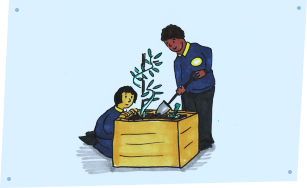Music
Intent
Music is a universal language that communicates across cultures and time. Appreciation of music can unlock a universe of cultural knowledge and understanding. At Garden Suburb Junior School, we aim to expose children to culturally significant music that they have never have heard and develop an understanding of context. Increasingly, music permeates every aspect of our lives. We recognise that music will underpin some of the most meaningful experiences that children will and also contributes to their good mental health. We create opportunities for all children to improvise, compose, perform and reflect; nurturing ambition and creating active, resilient music-makers.
Through our Music curriculum we intend to:
- Stimulate both the senses and the emotions
- Improve coordination
- Enhance wellbeing and promote group cohesion
- Develop ability to focus and listen
- Enrich knowledge of historically and internationally significant genres, pieces and figures.
- Encourage confidence in performing presenting work to others
- Deliver sound understanding of classical notation
- Support all children to make good progress through interventions and scaffolds
- Deliver highly interactive, collaborative lessons
- Develop resilience and willingness to try anything through a high tolerance for “failure” of ideas during the creative process
- Develop reflectiveness by giving regular opportunities for self-assessment and peer-assessment in all lessons
- Value respectful dialogue and disagreement in collaborative work
- Encourage a resourcefulness through wide and varied use of instruments for various uses
Implementation
The Music Curriculum at Garden Suburb Junior School is based upon the National Curriculum and informed by the Faber Music Key Stage Two scheme of work.
To deliver our Music curriculum we will:
- Provide lessons accessible to all with opportunities for higher-skilled children to deepen their knowledge and understanding
- Provide opportunities to read classical notation and apply this to writing their own rhythms and melodies
- Provide opportunities to interpret and create graphic notation using colour and shape
- Reference sol-fa notes and actions in learning about pitch, tempo, dynamics and timbre
- Encourage children to listen closely and precisely identify pitches by ear
- Allow children to revisit, practise and consolidate different areas of music
- Ensure all lessons have an aural/kinaesthetic and performing and listening element
- Teach understanding of rhythm and pitch, progressing onto reading and playing notes on a stave
- Build creativity into the learning cycles, with opportunities to improvise and compose, in a highly collaborative setting, involving creative decision making
- Place an emphasis on high standard and importance of listening and practising to making progress
- Find opportunities for cross-curricular links where possible
- Provide interventions for small groups of pupils and individuals in order to build self-esteem, vocal stamina and performance confidence.
We have links with BEAT (Barnet Educational Arts Trust) who provide continuing professional development. BEAT also provide individual teaching for those learning to play instruments (brass, woodwind, guitar, piano, strings and drums).
We have a school orchestra which incorporates children playing a range of instruments.
Children have the opportunity to join choirs (both upper and lower KS2)
All classes in Year 3-5 hold an annual assembly for parents in which music plays a key role.
Year 6 children take part in the ‘Year 6 Production’, a piece of musical theatre at the end of the year performed to parents and the wider community. Leading up to this production many rehearsals and interventions are held, in small groups and one-to-one, with the music coordinator focusing on performance technique and confidence.
Impact
The impact of the music curriculum is assessed with reference to the medium term planning taking into account the expectations of skills, knowledge and progression. Children are prepared to achieve age related expectations in music. Our children develop an appreciation and understanding of music which they can carry with them throughout their lives.
The impact of our Music curriculum is measured by:
- Ongoing formative observation
- Active participation in extracurricular activities
- Children’s willingness and ability to actively participate in performance
- Children’s willingness and ability to respond to creative challenges using their experience, personal taste and trial and error e.g. choice of instrumentation in composition
- Weekly or bi-weekly performance and recording of performance
- Self and peer assessment of class performance
- Opportunities for pupil voice
Assessment:
Music is assessed by the Music coordinator through continuous observations during lessons including recordings and written assessments. The Music curriculum is assessed on a formative basis. Children work towards regular recordings of their work for assessment purposes. There are also some opportunities for writing.
The assessment of our Music curriculum is measured through:
- Recording children’s work with on audio, video for teacher assessment and children’s self-assessment
- Monitoring of written and drawn composition and encourage self-reflection and assessment of overall structure and variety
- Understanding of rhythm and pitch skills in lower KS2 assessed by “Hear the Rhythm see the Rhythm” exercise; consisting of multiple choice activity
- Understanding of rhythm and pitch skills in KS2 assessed by dictation of melodies to be transcribed by children by ear
- Children’s willingness and ability to actively participate in performance
- Children’s willingness and ability to respond to creative challenges using their experience, personal taste and trial and error e.g. choice of instrumentation in composition.
- Children’s ability to comment and feedback on theirs and other’s performances making references to the musical elements

